The History of Caroline County, Maryland, From Its Beginning
Ridgely, Furman's Grove, The Plains
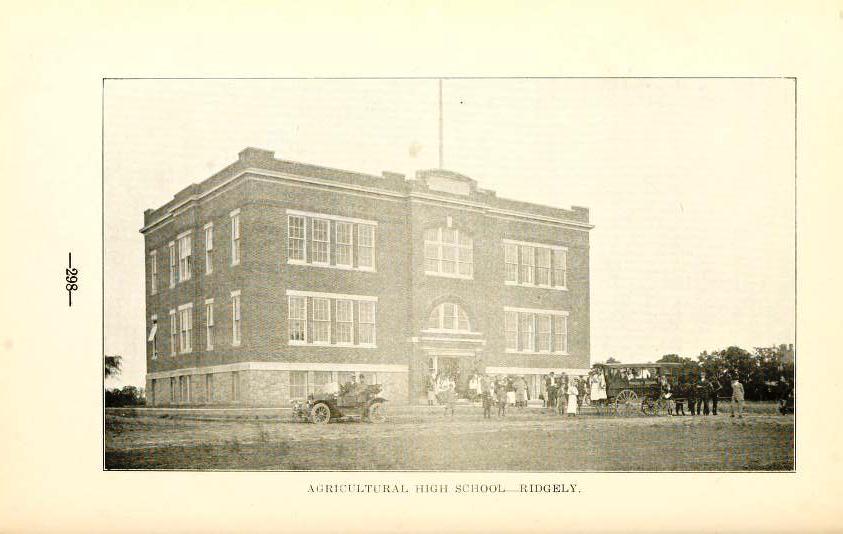
RIDGELY
The Founding
Ridgely did not happen into existence like the typical crossroads settlements which gradually extend along the turning highway until they suddenly discover themselves to be full fledged villages or towns. Ridgely was fully conceived and definitely planned before one building was erected on its site.
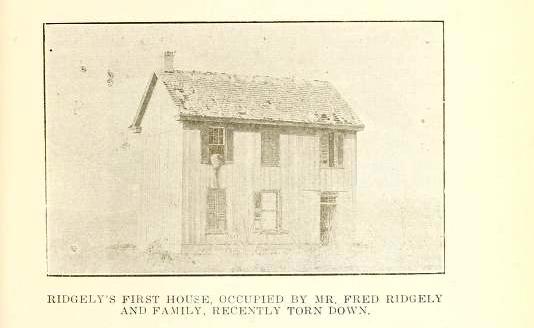
This whole survey resulted in the production of a most interesting map of Ridgely, showing the beautiful streets and avenues planned. Copies of this were used freely in attracting settlers to the contemplated city. The dream city, founded May 13, 1867, was born too early in this section of the state to become a reality, and it soon died. The reason for this was that the financial resources of the Company were not sufficient t enable them to accomplish their great undertaking. As the summer advanced, signs of this were much in evidence. Unpaid bills were accumulating and dissatisfaction was heard from lumber dealers, builders, painter, and day laborers. The city that had been started vanished with only a few buildings and a map left behind to record the unrealized dream.
After the failure of the Maryland and Baltimore Land Association, the real estate firm of Mancha Brothers united its activities in promising the growth of Ridgely; but for the first decade the most apparent growth lay outside the boundaries of the village. New settlers bought farms in the surrounding country where land was plentiful and cheap, and thus gradually the agricultural interests outside the hamlet and the commercial interests within, developed Ridgely into the busy railroad center it has increasingly become throughout its fifty years or more of history. Faith in the railroad was the great factor in holding Ridgely together and in promoting its growth.
The following are some of the earliest settlers in Ridgely - James K. Saulsbury, a merchant; J. Frank Mancha and Henry S. Mancha, real estate agents, who were instrumental in bringing northern settlers into this community; Sylvester Smith, who established a fruit evaporating industry, and James Swann, Ridgely's first teacher and later Superintendent of Schools of Caroline County. Other early settlers were Isaac J. Sigler, John A. Sigler, and Thomas W. Jones, Sr.
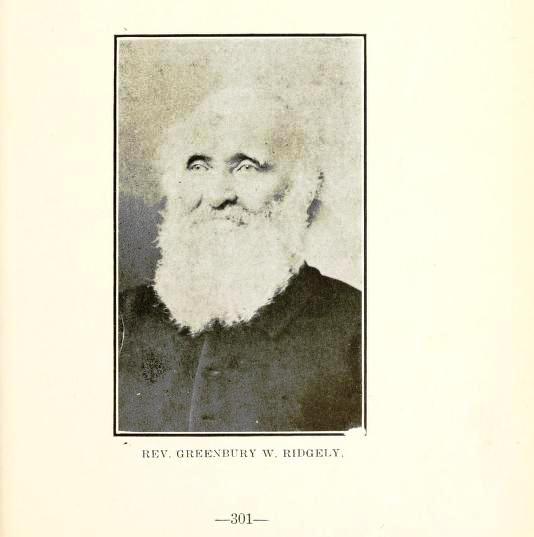
LIFE OF THE REVEREND MR. RIDGELY
The Reverend Greenbury W. Ridgely, in whose honor
the town of Ridgely was named, was born in Lexington, Kentucky, May 12,
1798. He attended the Transylvanian University, from which he
graduated, with honor. He then attended the law school of
Litchfield, Conn., where he formed a life-long friendship with John
M. Clayton, of Delaware. On Mr. Ridgely's
return trip to Lexington he visited families of his uncles, Judge
Richard and Henry Ridgely of
the Western Shore. Here he was induced to remain and study law.
After passing a successful examination, he became a member of the bar of
this state. After a brief period of legal practice in partnership
with Henry Clay, Mr. Ridgely decided
to enter the ministry of the Protestant Episcopal Church, and with this
idea he entered the Theological Seminary at Princeton, from which in the
course of time he was graduated.
While rector at Newtown he married Miss
Worth, of that place. His wife died in 1841 and shortly
afterward Mr. Ridgely became a rector
at Chester, Pennsylvania. While at this place he gradually
extended his ministerial work in building up new churches in the
vicinity. The churches at Marcus Hook and Claymont were the
outgrowth of his labors. In 1853 Mr. Ridgely came
to the Eastern Shore of Maryland to live. He settled in Caroline
County where he made large investments in real estate, purchasing from
four to five thousand acres of land. Although he was not assigned
to any parish, he constantly held services at places which were
destitute of churches. His last years were spent near our town at
the residence of his son, William S. Ridgely.
In August, 1893, Mr. Ridgely suffered a
stroke of paralysis from which he rallied; but a second attack shortly
afterward caused his death. He lies buried in the Episcopal
churchyard at Hillsboro. He left three children, none of whom are
living today. His second son, William S. Ridgely,
was for many years one of the most prominent citizens of Caroline
County.
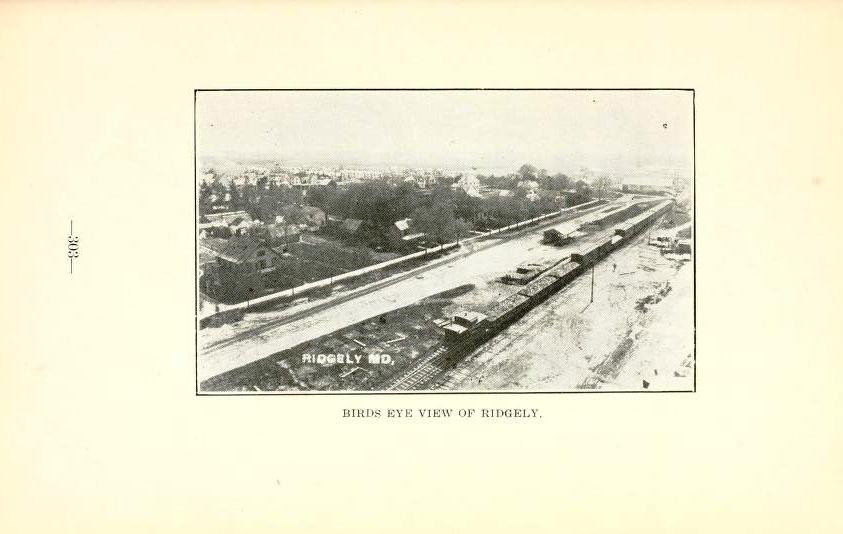
LIFE OF MR. THOMAS BELL
One of the leading men in this section of Caroline County at the time of the founding of Ridgely in 1867, was Mr. Thomas Bell. Mr. Bell was a large land owner with an attractive home near the proposed city; therefore it was natural that he should play an important part in the city's inauguration. Since his land joined the extensive holdings of Mr. Ridgely, he agreed to unite with him in selling enough property to enable the Land Association to carry forward its city scheme. By this agreement it fell to Mr. Bell to give the right of way at this point for the Maryland and Delaware Railroad, in its extension from Greensboro to Oxford. It also fell to his lot to provide sites for the railroad station and hotel built by the Land Association. Thus, in a very real sense, Mr. Bell started the town on its way. But the item of greatest interest that has to do with his share in the founding of Ridgely, is that he suggested, in the sale of lots, that if any ardent spirits were ever made or sold upon the premises, the owner of the lot should forfeit it will all its improvements to the parties from whom it was purchased; thus the town of Ridgely has been blessed throughout its years in being numbered among the ranks of the "dry."
EARLY CONDITIONS
The early conditions of Ridgely, as far as schools and churches were
concerned, were poor, the settlers having to go to Boonsboro for both.
The first school of Ridgely was built in 1872 and was called "Sedge
Field Academy." This was a one-roomed school of which Mr.
Swann was the first teacher. It is said that this
was the first school in the county to have desks built with reference to
the size of the pupils. This one-roomed building is now a part of
a dwelling on Second Street. Church services were held in the
school house until 1877, when the Methodist Church at Boonsboro was
taken down and rebuilt on the site of the present Methodist Church, the
land being given by
Mr. Ridgely.
ADDITION OF CHURCHES
As time passed and Ridgely grew in population, more churches were added
and better buildings planned. The second church in Ridgely was St.
Paul's Reformed Church built in 1880,
Mr. Hannebury having been its founder and first
minister. Later this church was remodeled. In 1895 the
present Methodist Church was built, the former house of worship having
been moved back on Maple Avenue to become a dwelling. Then came
the Catholic Church in 1896, the Brethren in 1898, the Baptist in 1909
and the Dunkard the same year.
DEVELOPMENT OF SCHOOLS
Just as many churches were added, so school conditions improved with population. The little one-roomed school was found inadequate; hence in 1888 the present Primary School was started. It, at first, had but two rooms, gradually three more were added. In 1910 this became a high school. After much careful consideration in keeping with the advancement along industrial and commercial lines, a delegation of representative citizens of Ridgely met the County School Board at Denton during April 1910, for the purpose of discussing plans relative to the establishment of an agricultural high school in their community. Courses in agriculture, chemistry, animal husbandry, and manual training having been added to the school curriculum, and many pupils having come in from the surrounding country to avail themselves of the privilege of them and of a high school training, it was pointed out how necessary it was to have a well equipped modern building in which to teach these practical subjects. Due to the untiring efforts of such men as W. W. Seward, Hon. T. A. Smith and others, the money necessary for such a building was pledged and a tract of land was secured which would provide a convenient and suitable site for the school as well as furnish types of soil for a successful demonstration farm. It was hoped that the State would eventually become interested in starting an Eastern Shore Experimental Station here. The school building was completed July 1912 and formally opened with appropriate exercises September 12, 1912.
THE STATE FARM
At the request of the Caroline County School Board there was introduced into the Legislature in the session of 1914 a bill to transfer fifty acres of the land purchased for the Ridgely Agricultural High School to the Maryland Agricultural College; this passed and the State reimbursed the Caroline County Board for the amount which the farm had cost them. The farm has been used largely to supplement the investigations being conducted at the Maryland State College so as to check up results and make them applicable to Eastern Shore soil and climatic conditions.
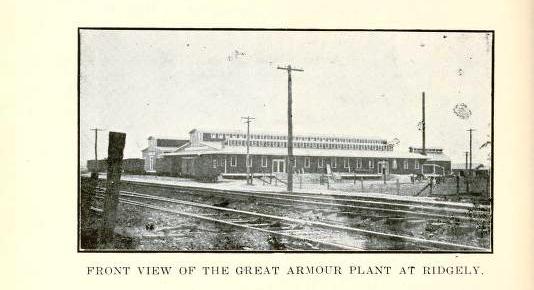
INDUSTRIES
On account of Ridgely's many industries the population greatly
increased. The Armour Plant, one of the largest strawberry
preserving factories in the world, was located here because it seemed
the most favorable region from which to secure large yields of this
fruit. However, many carloads are also purchased and shipped in
from other states to be preserved here. This plant employs a
thousand people during the strawberry season, the majority of whom are
foreigners. The company has settlements of its own where foreign
help is housed. Everything about the settlement and building is
kept in a thoroughly approved sanitary condition.
Swing & Company's Factory is one of
the leading canning enterprises of the kind in the county. This
factory packs tomatoes exclusively, using the yield from three or four
hundred acres of ground. In connection with this, Swing & Co. have
a basket factory which has gained a reputation throughout Maryland and
New Jersey. Millions of baskets, crates, and strawberry cups are
manufactured, thus giving permanent employment to many.
The Saulsbury Brothers
also own and operate a large canning factory here, putting up tomatoes,
corn, and peas. A large acreage of these crops is put in each year
to supply this factory. Foreign as well as local help is employed.
SUMMIT POULTRY FARM
The Summit Poultry Farm of Holsinger & Son covers sixteen acres, being one of the largest in the East. It has a hatching capacity of 17,000 eggs and as many as 7,000 day old chicks are shipped daily to different parts of the United States. Eggs and chicks of frying size are also shipped.
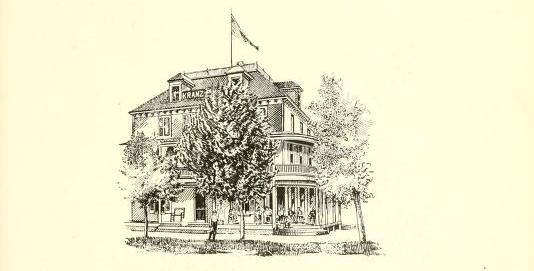
IMPROVEMENTS
During Ridgely's later years many improvements have been made, chief
among which are:
A water works
system having a capacity of 65,000 gallons;
A town
sewerage system with a sewerage disposal plant.
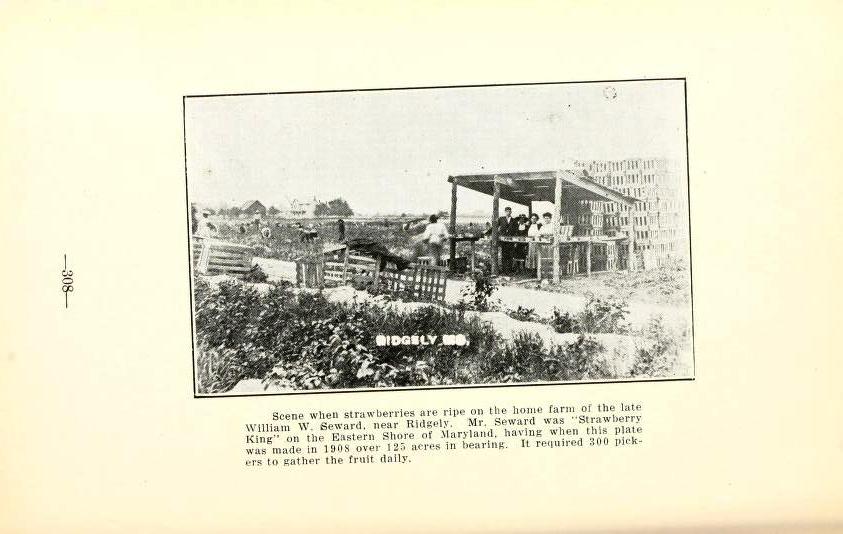
A fire department well equipped with a power house and pumping station.
A library
with a splendid collection of books.
Compiled from the History of Miss Emma Grant Saulsbury and others by the Teachers and Pupils of the Ridgely School.
FURMAN'S GROVE
Furman 's Grove, better known as Jumptown, was one of the earliest
settled portions of the county. When the county was formed, the Tuckahoe
had been dammed and a mill near the present Crouse Mill, was then in
operation. This was considerably before 1800.
The Bradleys were
prominent residents ill this section in those long ago times and in fact
influential in the county. Their burying ground is on the Starkey farm
across from the school. On some of the rough stones may be
deciphered the names or initials of some of these early people.
Bradleysburg was quite a thriving
hamlet at this time doubtless. This name evidently continued after the
settlement ceased to be, for a county map made in 1875 by J.
B. Isler locates this place.
Following the Bradley family
in the neighborhood came the Jumps, one of the
earliest and best known of whom was Abraham Jump,
also a prominent citizen in the county in his time. He is buried
near the Brickyard below Ridgely. Josiah Jump was
at one time clerk of the Circuit Court for Caroline County.
Later on a family by the name of Starkey acquired
nearly all the land in this section.
Several families of German people
came from Baltimore and Pennsylvania and settled not far from where
Jumptown church now stands. The houses were built in the meadow
near the east side of the branch on what is now Mr. M.
C. Smith’s farm. The settlement was named
Germantown on account of the nationality of its settlers. The houses
were all made of logs thatched with mud. One house was built
partly in the bank of the stream.
The names of some of the settlers of
Germantown were: J. R. Lynch, Otto Gephart, Old
Christina, John Reinhart, known as Dutch
John, and a family of Kierschs.
The industries of the German people were basket, cigar, syrup, and cider
making. The tobacco for the cigars was not grown here. It was
shipped here from the south. The tobacco factory was owned by Otto
Gephart. It was a part of his home. The whole family
helped make the cigars. They were then peddled around the country.
Willows for the basket making were
grown on several acres of land in the meadows. When they were the right
height these were cut and stripped of their bark. Then they
were sent away to be sold. An old woman, usually called "Old
Christina," made very beautiful baskets out of some
lighter material. It was probably a sort of straw.
The original church in this section
was built at a very early period, judging from some old records. Started
as a Methodist church and continued as such for several generations, at
one time the Holiness society worshipped within its walls, then again
the Methodist took charge and now for several years the Baptist
denomination has been in control, the minister living in Ridgely.
The present name of Jumptown has clung to the church because of the aid
and support once given by Abraham Jump and
his family.
A school was early established in
this section also, though the earliest official record of same was made
in 1865 at which time trustees were appointed by the County School
Board.
About 1888 the name of this school
was changed to Furman's Grove for a Mr. Furman who
donated land for a site. A new building was later erected.
Contributed by the School.
THE PLAINS
The family connection of Mrs. Bourne, the former
owner of the above named estate, was perhaps among the most noted of the
Maryland aristocrats. Her father, Isaac Purnell,
was a typical southern gentleman and married a daughter of Benjamin
Sylvester, a large land holder in ante-bellum times. The Purnell family
was very wealthy and maintained all the social customs of the old
Dominion aristocracy. Slaves, about 75 in number, were housed in a
row of small shanties near the mansion. The master of the
plantation was very liberal to the poor, but he had many eccentricities;
among which was a dignity and reserve maintained towards his commonplace
neighbors. When driving about the country his coachman and footman
were dressed in livery, and four coal black horses in silver mounted
harness were attached to the family coach. The late Mrs.
Bourne, when Miss Mary Purnell, inherited "The
Plains" at the death of her grandfather, Mr. Sylvester.
The heiress was twice married; her first husband was Allan
Thorndyke. Mr. Bourne, her last husband, was
very wealthy and at his death the widow inherited several millions of
dollars to add to her already large possessions. Mrs.
Bourne died at Newport in 1881 leaving property
estimated at ten million dollars to her children and grandchildren.
For many years prior to her demise Mrs. Bourne made
an occasional visit to her estate in this county, though never residing
here for any length of time. Much of her time was probably
spent in Europe. She expended probably one-fourth of a million
dollars on "The Plains" estate and her various possessions in all
amounted to several thousand acres of the county's choicest land.
Social life surely had a golden era
at this Eden of the Eastern Shore, of which many unique anecdotes are
extant. One in particular is as amusing as it is unique. A
certain member of this ancestral family was passionately fond of
sleighing. A longing for this sport seized him at an inopportune
season of the year--July. Then, as now, artificial means were
resorted to, as this incident goes on to prove. A supply of salt
was procured to cover the mile-lane drive. Let us hope that our
impulsive sportsman enjoyed the jingle of the sleigh bells, since he
could not the snow breeze, which would be a boon in such a scorching
month. To question the veracity of this anecdote would bring one
back again to "Mother Goose" and "Fairy Tale" days. However, it
goes to prove that money was not wanting at the Bourne Manor during
those days when Maryland's proverbial hospitality had been amicably
partaken of at The Plains.
In the course of events Providence
ordained other scenes to be enacted on this same eventful stage in which
society once held so prominent a part. In the year 1887 a
community of ascetic women, known as Benedictine Sisters, purchased this
"Paradise of the Plains" from Allan Thorndyke Rice,
ci-devant editor of the North American Review.
The property consists of five hundred and fifty acres of arable and two
hundred acres of timber land. It is situated in the heart of the
farming region of the Eastern Peninsula. The elaborate buildings
were erected by Mrs. M.M. Bourne, grandmother of Mr. Rice, and cost over
one hundred and twenty-five thousand dollars. The building
material was of the finest. Modern critics say that it could not
be purchased in our day at any cost. The workmanship, too, has
stood the wear and tear of time, for the buildings seem as substantial
now as if they were of modern construction.
The Convent and Academy, St.
Gertrude's were incorporated in the year 1896, under the laws of the
State of Maryland. The Mother House of this community is located
in Newark, New Jersey, where a large branch house is established, with
two others in Wilmington, Delaware.
Aims of St. Gertrude's Academy.
Harmonious education, while providing sound mental and moral training,
must not endanger the growth of the body. Of all places a boarding
school in the country is a place to assist the development of the body.
The country air is stimulating and has health giving properties that are
lacking in most city schools, whose environments are usually limited.
Catholic pupils are given a course of
instruction in their religion, but no undue influence is exercised over
the minds of non-Catholics. For maintenance of order, all are
obliged to conform to the external religious exercises of the
institution.
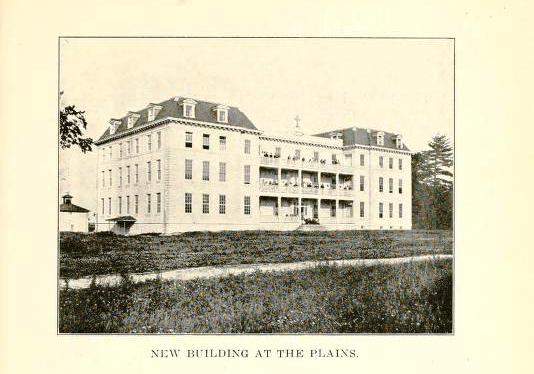
Art. Art is now recognized as one of the essentials of a refined education. Hence, special attention, under a competent teacher, is given to this study. Music and drawing are also made a specialty.
Domestic Service. "Cooking is an art; a noble science." Lectures and experimental lessons in cooking and baking are given to the students who are interested in home economy.
Domestic Art. Every style is taught--both plain and ornamental--from cutting out and making of a simple wearing apparel, to the designing and embroidering an elaborate shirt waist, center piece, etc.